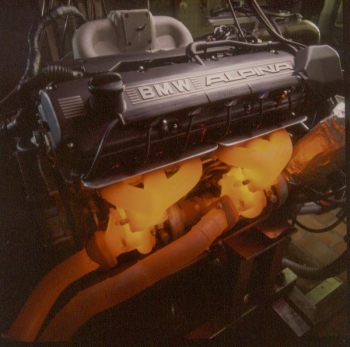 |
In March 1989, at the Geneva motorshow, Alpina introduced their fastest car thus far, the B10 BiTurbo, based on the 535i.
The B10 BiTurbo took two years to develop and cost a staggering $3.2 million in R&D. But it paid off. The 3.5 litre, twin-turbocharged six-cylinder engine is considered to be one of the best turbocharged engines ever.
In the September 1991 issue of Road & Track magazine, Paul Frère wrote: “For me this is the car … I think this is the best 4-door in the world”.
Despite a base price tag of 146,800 DM, nearly twice the price of an E34 M5, the B10 BiTurbo became the best-selling model in Alpina history up to that point.
Production ended in 1994 due to termination of the M30 engine by BMW. The last examples of the 535i with M30 engine were delivered by BMW to Alpina for producing the final 50 examples of the B10 BiTurbo.
Engine/Gearbox
 |
The stock BMW 3.5 liter engine is completely dismantled. Alpina installed forged Mahle pistons, re-balanced all moving pieces and re-machined the combustion chambers. The new pistons, which have oil-spray cooling of the undersides, are installed with stronger connecting rods. The pistons bring the compression ratio down to 7.2:1. New valves – sodium-cooled on the exhaust side – and a new camshaft are also fitted. The intake and exhaust systems are Alpina’s own production.
The new exhaust manifolds include twin Garrett T25 water-cooled turbochargers with an integrated, electronically controlled wastegates feeding the engine through a huge intercooler, which stretches from just below the kidney grille down to the bottom of the spoiler. The advantage of two smaller turbochargers is that the same air volume is possible as a single larger unit but with much less turbo lag. The exhaust system – manufactured by Boysen – is made of stainless steel and includes six metal-core catalysts with Lambda-Sonde control.
Fuel injection and ignition are reprogrammed Bosch Motronic. The B10 BiTurbo has variable boost control made by Bosch, which is adjustable from in the car to between 0,4-0,8 bar. The result at full boost is an output of 360 bhp and 520 Nm of torque.
Alpina have fitted a stronger Fichtel & Sachs clutch and a specially developed Getrag 5-speed gearbox to transmit the drive to the beefed-up rear axle, which includes a 25-percent limited-slip differential.
Suspension/Brakes/Wheels
Linear-rate springs are installed all around with anti-roll bars and Bilstein-damped front struts. At the rear, the Fichtel & Sachs shock absorbers also control the ride height, which is hydraulically adjusted by an electronically operated high-pressure system. The 17in Alpina alloys make room from larger-than-standard Girling ventilated disks with Lucas 4-piston front calipers. The low-profile Michelin tires are 235 mm wide front and 265 mm wide rear.
Interior/Exterior
Inside, Recaro sportseats in anthracite Alpina cloth, leather-covered Momo steering-wheel and polished wood interior were installed. The B10 BiTurbo also has new instruments and digital-indicators for engine-oil temperature, rear axle-oil temperature, turbo boost and oil-pressure.
Exterior changes include a front spoiler, rear spoiler, exhaust pipes and the wheels. The stripes are optional.
The final 50 BiTurbos have the wider kidneys of the V8-engined 5-series cars, facelifted rearview mirrors and new rear spoiler. The Alpina cloth interior is changed to the luxurious “Alpina-wasserbüffel” leather interior as standard. The final 50 B10 BiTurbos also have unique instruments with blue background.
Performance
Alpina claimed a 0-100 km/h time of 5,6 seconds and a top speed of over 290 km/h. 200 km/h is passed after around 19 seconds.
Production
The first car was delivered in August 1989. The last car produced in August 1994 still belongs to Alpina.
In total 507 examples were produced.